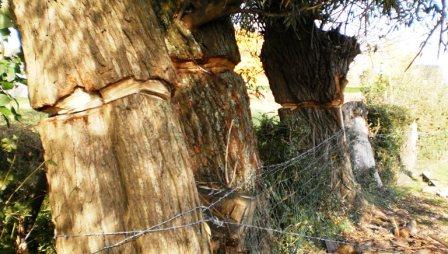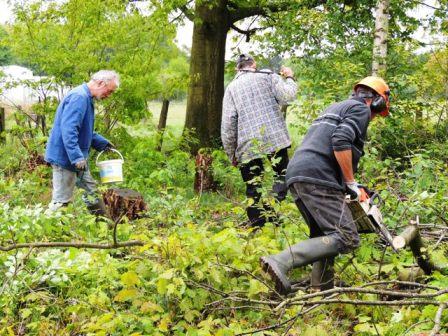Angry neighbors often dare to give anonymously on the Internet the advice to drill holes and there in to put copper screws, petroleum (even hydrochloric acid, very dangerous!) or herbicide. I have no idea if this works. In principle, the wood core is death. Only the outer layer just under the bark, lives and transports fluids and nutrients.
Killing a standing tree so can be done by girdling: cut and remove a ring of 10 to 15 cm bark around him.
For a large, mature tree, the treatment should be more extensive and more frequently.
To pull out young trees there is a lever clamp: the tree popper.
 In nature exotics as black cherry (and - oak) are fought by pulling and felling. The edge of the stump is then rubbed with glyphosate. (Cutting of the outer layer to the root would also prevent new shoots.)
In nature exotics as black cherry (and - oak) are fought by pulling and felling. The edge of the stump is then rubbed with glyphosate. (Cutting of the outer layer to the root would also prevent new shoots.)
A pair of cuts in the stump can give water, fungi and micro- organisms a better access to accelerate the process of decomposition.
I wonder whether it is not possible to infect the stumps with a fungus. Just as shiitake and other mushrooms grown on dead wood with dowels (sticks) with spawn to 'plant' or graft in holes, I think this would also be possible with fungi that feed on living wood.
Fungi usually live on dead wood. But trees and mushrooms as sulfur fungus or honey fungus (Armillaria mellea) can live for decades with no problems together. If a tree fungus can penetrate, it is often because that is weakened, e.g. by strong pruning, storm damage or a bad pitch.
Digesting wood takes years, a stump after an infection is not yet gone after 3 years. Usually there are successive types of fungi. Among others giant polupore (Meripilus giganteus), shelf fungus (Ganoderma adspersum), honey fungus grow on living wood. But certainly in the latter other trees will be affected in the neighborhood. Not really a good solution so.
But green researchers may find sooner or later a suitable mold to vaccinate black cherry and other exotics to let them die standing..?
Saving a heavily wounded tree is sometimes possible. As a large part of the bark is swept away by e.g. a collision, you can try to make a bypass cutting a series of young twigs of the tree and fix them solid from top to bottom of the wound in the bark on the trunk as a grafted bridge. This bridge grafting can be covered with grafting wax.
Sometimes unwanted trees are pruned to dead: so drastically pruned that they do not survive (long).
I have very much to my surprise found that this page is very popular on the website. Murder a tree I find really nothing to go lightly over. A tree represents life. In many cultures, a new tree is planted at birth (whether or not on the placenta). Complete birth forests. Without trees there would be no life possible.
The usefulness of trees
Trees and other plants to filter fine particulates from the air. Scots pine forests take in Flanders annually about 260 tons of particulate matter from the air. Bioengineer Thomas Schaubroeck calculated that this is a health benefits worth some 40 million euros. VITO (Flemish Institute for Technological Research) calculated that each kilogram of fine particles PM2.5 that is extracted from the air accounted for 150 euros saved costs, so we perhaps underestimate the "real" economic value of these forests.
Fine particles to the average person take one healthy year of his life. (By respiratory symptoms, lung function, deposits on vessels, risk of heart attack, carcinogens such as polyaromatic hydrocarbons (PAHs).
'Trees are worth much more than you think'
Trees make and keep the earth habitable for animals and humans. They produce humus and oxygen and put carbon dioxide firmly in their timber. They deliver lumber, paper and fuel. Their roots hold the soil firmly and protect against erosion. They catch with their leaves dust from the air and protect against sun, rain and wind. They dominate the landscape. They hold water and purify it, mitigate climate change and reduce the risk of flooding. They get nutrients, water and minerals from deep in the earth upwards. They reduce noise and househousands of insects and animals. Many trees give us fruits (and sugars) and protection. Trees give life!
On earth there are 60,065 tree species of which 9,600 are threatened with extinction. Of the tree species, 58 percent only occurs in one country. Brazil has the most species, 8,715, of which 4,333 can only be found on its territory. Colombia is in second place with 5,776 tree species and Indonesia is third with 5,142 species. Madagascar has nearly 3,000-, and Australia has about 2,500 unique species.

An adult beech has 80,000 leaves. An old one even 0.5 million. I read. On a hot summer's day, hundreds of liters of water evaporate, which is transported upwards at a speed of 32 km / h??.
A few days earlier I read that the juice flow is on average 1 cm / sec, that is 36m / h or almost 1,000 times less?
Of course, the speed depends on the type of tree and the evaporation rate. At night the speed is lower. The diameter of the vessels also plays a role. In wide barrels (diameter 1007200 Gm) 16.745 m / h (4.713 mm / sec) is achieved, in narrower barrels (25775 Gm) speeds between 1 and 6 m / h (0.3 - 1.7 mm / sec). In an oak, water is transported faster (45 m / h) than in an ash (25 m / h). An active tree can transport 300 liters of water per day. In herbaceous crops, speeds of a few dozen meters per hour are measured and in lianas 150 m / h.
